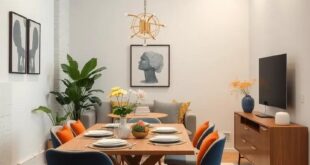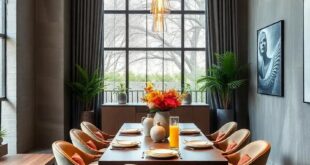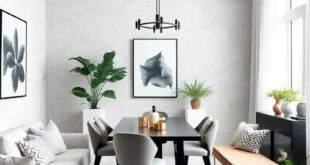illuminate Your Space: 25 Essential Tips for Choosing the Perfect Dining room lamp
When it comes to setting the right mood in your dining room, lighting is the unsung hero that can transform an ordinary meal into an extraordinary experience. The perfect lamp not only enhances the visual appeal of your space, but it also serves as a functional piece that brings warmth and ambiance to your gatherings. In this listicle, we’ve gathered 25 essential tips that will guide you thru the process of selecting the ideal dining room lamp. From understanding different lighting styles to considering the materials and bulb types, you’ll gain valuable insights into how to elevate your dining area. Whether you’re aiming for a cozy, intimate feel or a more vibrant atmosphere, our curated advice will help you light up your space and create memorable moments around the table. Let’s delve in and brighten up your dining experience!
Consider the size of your dining room: A lamp that fits the scale of your space will create harmony and balance
Choosing a lamp that harmonizes with your dining room’s dimensions is essential for achieving a cohesive look. An oversized fixture in a small room can overwhelm the space, making it feel cramped and uncomfortable. Conversely, a tiny lamp in a large room may look lost and fail to provide adequate illumination. Consider these tips when evaluating the scale of your dining area:
- Measure Your Space: before shopping, measure the height and width of your dining room. Use these dimensions to guide you in selecting a lamp that suits the space.
- Ceiling Height: If your ceilings are high, don’t shy away from larger pendant lights or chandeliers that draw the eye upward.
- Table Size: Your lamp should complement the size of your dining table; for wider tables, a wider lamp or cluster of smaller lights can work beautifully.
- Placement Considerations: Ensure that your lamp’s placement allows for easy visibility and doesn’t obstruct conversation.
To better understand how to match a lamp to your dining room, refer to the following guidelines:
| Room Size | Recommended Fixture Size |
|---|---|
| Small (Under 100 sq. ft.) | 12-20 inches in diameter |
| Medium (100-200 sq. ft.) | 20-30 inches in diameter |
| Large (Over 200 sq. ft.) | 30+ inches in diameter |
By prioritizing the size of your dining room, you can select a lamp that enhances the overall ambiance without overwhelming the space, creating a balanced and inviting atmosphere for gatherings and meals.
Match your lamp style to your decor: Choose a lamp that complements your existing design theme, be it modern, rustic, or traditional
When selecting the perfect lamp for your dining room, it is essential to ensure that its style aligns seamlessly with your existing décor. A lamp that complements your design theme not only enhances the ambience but also creates a cohesive look. For those with a modern aesthetic, consider sleek, geometric designs in materials like metal or glass, which can add a contemporary flair. In contrast, if your space exudes a rustic charm, opt for lamps made of wood or featuring organic textures to emphasize warmth and a cozy atmosphere. For a traditional setting, a classic table or chandelier with ornate detailing can serve as a timeless piece that evokes elegance and sophistication.
to narrow down your options, here are a few suggestions for matching lamp styles to various décor themes:
- Modern: Minimalist designs with clean lines
- Rustic: Lantern-style lamps and handmade pottery
- Traditional: Crystal chandeliers or antique brass fixtures
- Industrial: Vintage Edison bulbs with exposed wiring
| Design Theme | Lamp Style |
|---|---|
| Modern | Sleek metal or glass |
| Rustic | Wooden or earthy textures |
| Traditional | Ornate chandeliers |
| industrial | Exposed bulbs and raw finishes |
Pay attention to the height: The ideal height for a dining room lamp is typically 30-36 inches above the table, but adjust for your ceiling height
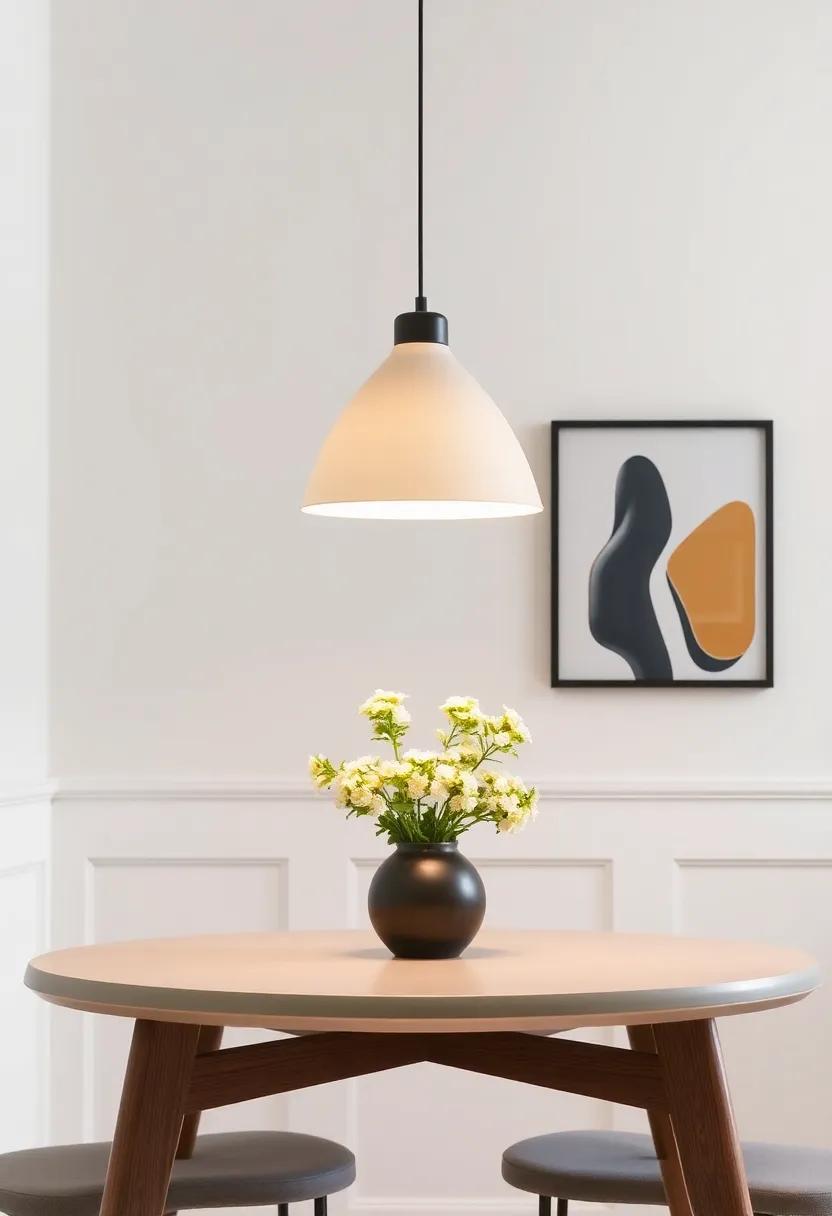
when enhancing your dining room’s illumination, the height of your lamp plays a crucial role in both functionality and aesthetics.Typically, a dining room lamp should hang between 30 to 36 inches above the table to ensure it casts light effectively without obstructing views.Though, considering varying ceiling heights is essential. For lower ceilings, aim for the lower end of the spectrum, while higher ceilings allow for a bit more flexibility, letting you position the lamp at greater heights for that coveted layered lighting effect.
Creating a warm and inviting atmosphere goes beyond mere positioning; it can affect the overall dynamics of your dining space. When selecting the perfect height, think about the following considerations:
- Table height: Standard dining tables average 28 to 30 inches high.
- Ceiling Height: Measure from the table to the ceiling to determine the optimal drop.
- Light Features: If your lamp includes multiple bulbs, you might opt to hang it slightly higher to diffuse the light evenly.
to aid your decision-making, refer to the table below which outlines various ceiling heights and corresponding recommended lamp heights:
| Ceiling Height | Ideal Lamp Height Above Table |
|---|---|
| Up to 8 ft | 30 in |
| 8 ft to 9 ft | 30-36 in |
| 9 ft to 10 ft | 36-40 in |
| Above 10 ft | 40 in and up |
Opt for dimmable options: A dimmer switch allows you to adjust the light for different occasions, from bright family dinners to intimate gatherings
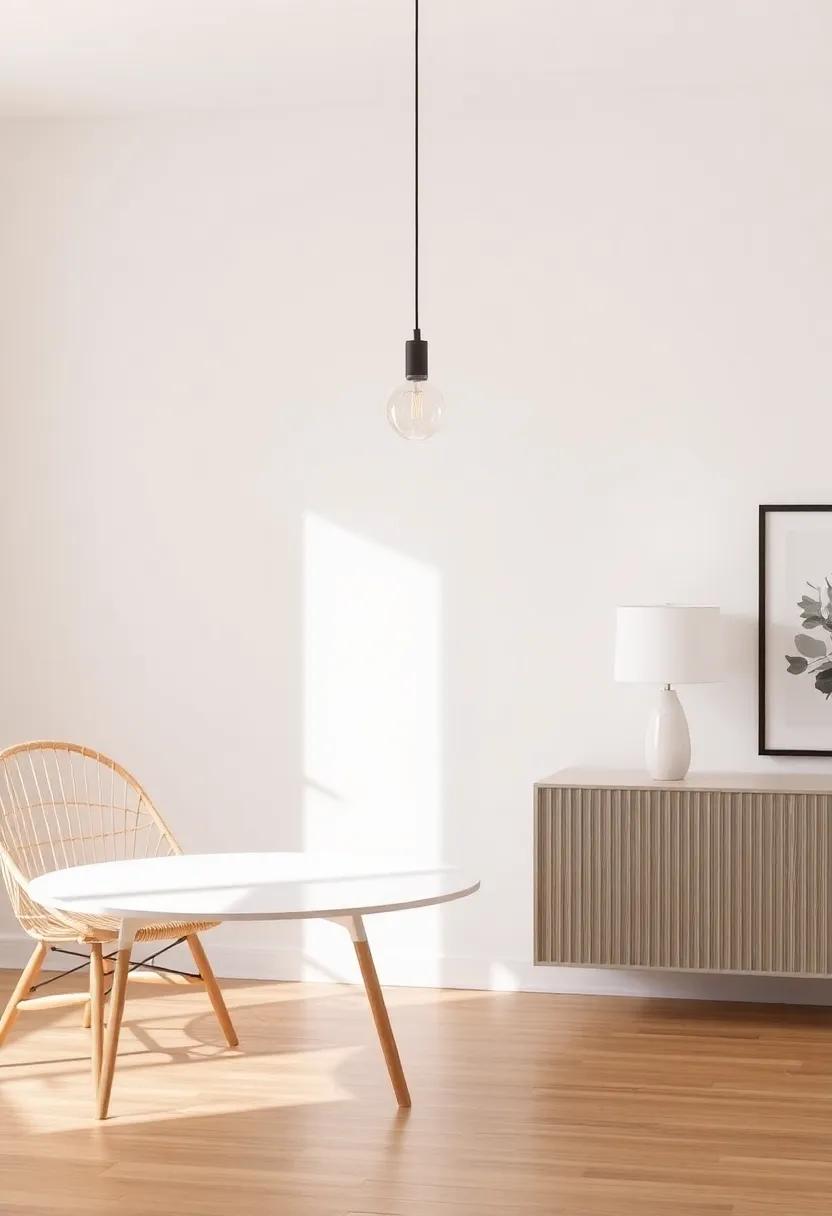
Adjusting the ambiance of your dining area to match the occasion can transform the entire atmosphere of your home. A dimmer switch provides the flexibility to modify lighting intensity, making it ideal for various scenarios. Picture this: hosting a vibrant family dinner where laughter echoes around the table. With a quick adjustment of the dimmer, you can brighten up the room to ensure no one misses any fun moment.Conversely,for those cozy,intimate gatherings with friends or a romantic dinner for two,a soft,warm light can create a comforting and inviting setting. The ability to manipulate brightness is more than just a convenience; it can immensely impact the mood and functionality of your space.
When selecting a dimmer switch, consider the following features to enhance your dining experience:
- Compatibility: Ensure that the dimmer works seamlessly with your chosen light bulbs.
- Style: Pick a dimmer that blends with your decor—modern, vintage, or minimalist.
- Smart technology: Opt for smart dimmers that can be controlled remotely or via voice commands.
- Ease of installation: Look for user-friendly dimmer options that don’t require extensive electrical work.
Table of Dimmer Features:
| Feature | Description |
|---|---|
| Compatibility | Works with LEAD, incandescent, and CFL bulbs |
| Control Type | Manual, remote, or app-controlled |
| Design | Variety of colors and finishes available |
Choose the right bulb: LED bulbs offer energy efficiency, while incandescent bulbs provide warmth—pick based on your preferred ambiance

When selecting lighting for your dining room, your choice of bulb can significantly influence the overall ambiance. LED bulbs are a top contender for those seeking energy efficiency, typically consuming up to 80% less energy than their incandescent counterparts while offering a lifespan of up to 25,000 hours. If you’re committed to lowering your electricity bills and reducing your carbon footprint, LED bulbs come in a variety of color temperatures, allowing you to customize the atmosphere—whether you prefer a cool, crisp white or a soft, warm glow. Furthermore, many LED bulbs now emulate the cozy feel of traditional lighting, proving that you don’t have to sacrifice aesthetics for efficiency.On the other hand, incandescent bulbs impart a warm, inviting glow that is unmatched in creating a homey feel. Their ability to render colors beautifully makes them ideal for spaces where you want to enhance the visual richness of your decor and the food you serve. However, with their shorter lifespan and higher energy consumption, they may require more frequent replacement and cost more over time. For those striving for a traditional dining experience,incandescent bulbs could be worth the extra energy cost. Ultimately, consider the mood you wish to create: do you desire a more modern, clean vibe with LEDs or a classic, intimate setting with incandescent lights? The choice can transform your dining experience.
| Bulb Type | Energy Efficiency | Typical Lifespan | Ambiance |
|---|---|---|---|
| LED | High (80% less energy) | 25,000 hours | Cool to warm (customizable) |
| Incandescent | Low | 1,000 hours | Warm and inviting |
Think about the lamp shape: Round lamps can soften hard lines in a room, while rectangular or linear types add a modern touch
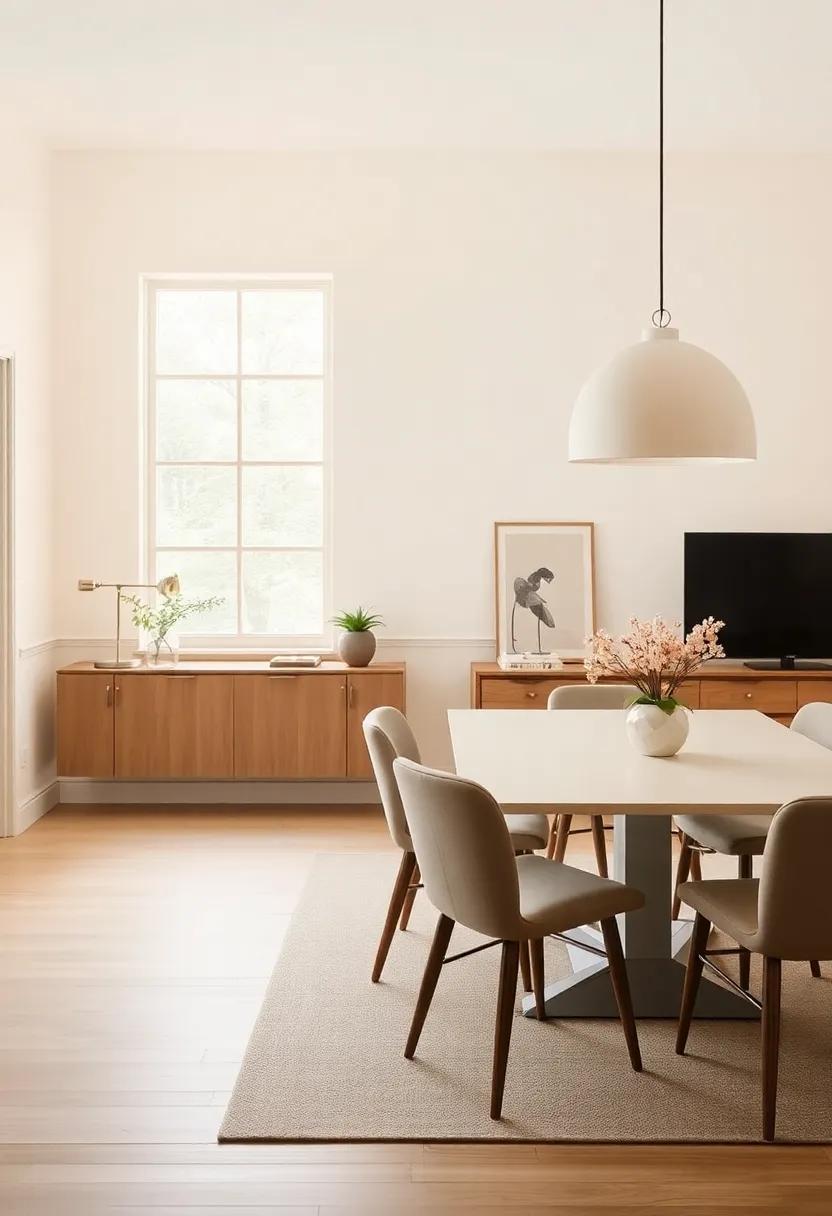
When selecting a dining room lamp, consider how the shape will interact with the overall design of your space. Round lamps can introduce a sense of warmth and softness,providing a delightful contrast to sharp angles and hard lines often found in modern furniture designs. They’re perfect for creating an inviting atmosphere, making them ideal for gatherings with family and friends. Picture a chic, round pendant hanging gracefully above your table, casting a gentle glow that envelops guests in comfort while complementing the cozy aesthetic of your dining area.
On the flip side, rectangular or linear lamps offer a sleek, contemporary vibe that can elevate your dining experience. These designs are fantastic for minimalist settings or spaces aimed at a more elegant style. They can emphasize elongated tables effectively, enhancing the eye’s natural movement along the lines of the furnishings. A streamlined linear fixture suspended over your dining table can add a striking focus and bring an element of architectural elegance to the room—truly making it a statement piece.
Explore color temperature: Warmer light (2700K-3000K) creates a cozy atmosphere, while cooler light is suitable for a more vibrant feel
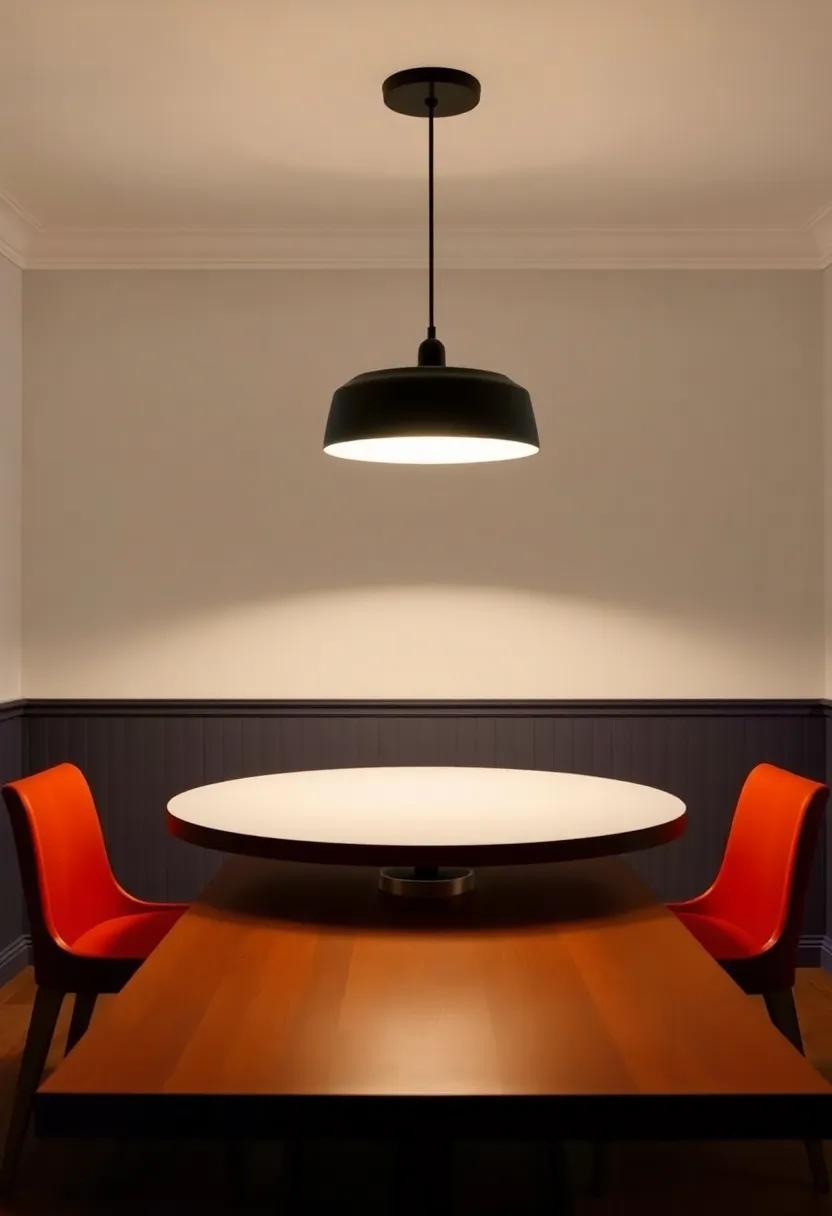
When it comes to setting the mood in your dining room,the color temperature of your lighting plays a significant role. Choosing a lamp that emits warmer light,typically in the range of 2700K to 3000K,envelops the space with a soft,inviting glow. This warm hue not only enhances the richness of your dinnerware and food presentation but also fosters a comforting environment that encourages conversation and relaxation among your guests. Whether it’s a casual weeknight dinner or a festive gathering, warmer light can transform your dining experience into something special.
On the flip side, if you’re aiming for a more energetic and vibrant atmosphere, consider opting for cooler light sources, often exceeding 4000K.This cooler spectrum adds a crispness to your dining room, making colors pop and creating a lively ambiance. Such lighting can be especially effective in contemporary or modern décor styles, as it complements sleek lines and bright accents. Here’s a quick comparison that illustrates the impact of different color temperatures:
| Color Temperature | Effect on Atmosphere | Ideal uses |
|---|---|---|
| Warm (2700K-3000K) | Cozy, inviting | Family dinners, intimate gatherings |
| Cool (4000K+) | Bright, vibrant | Brunch parties, modern settings |
Look for statement pieces: Don’t shy away from bold designs that reflect your personality and serve as a conversation starter
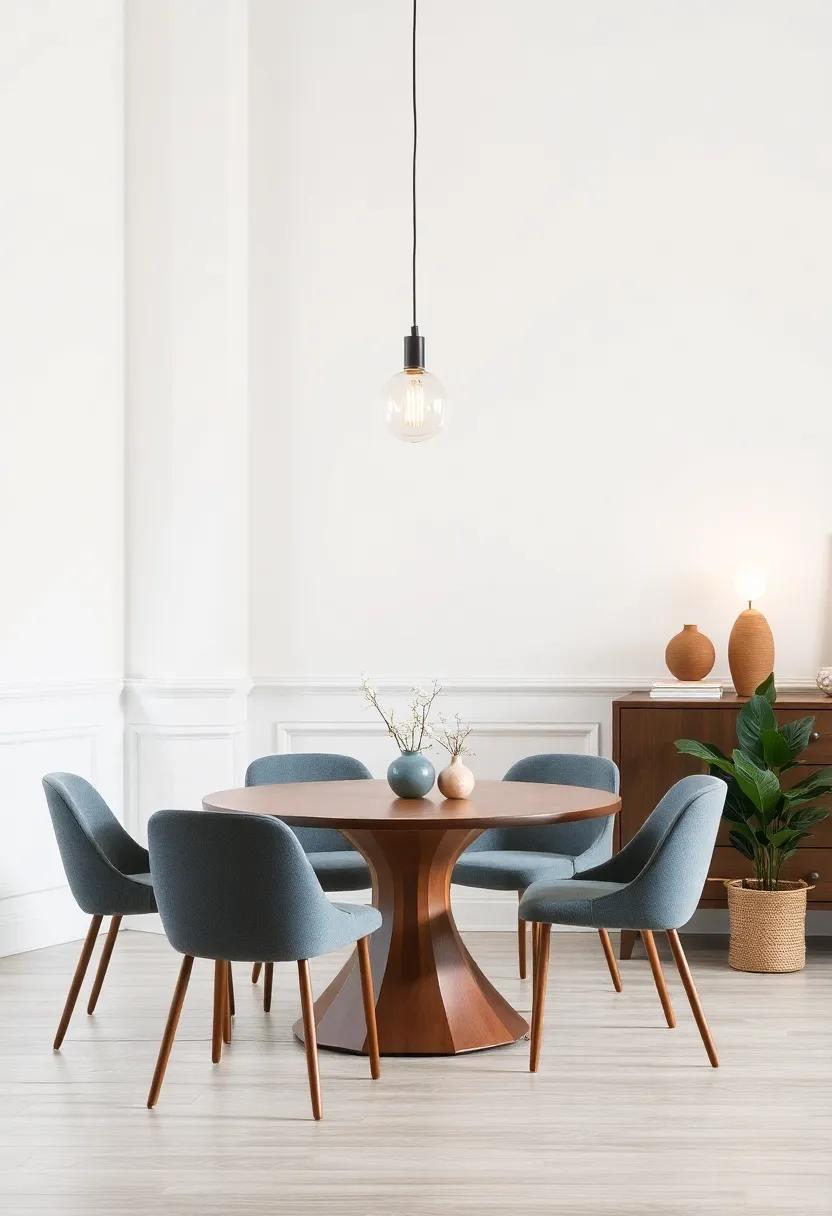
When it comes to illuminating your dining room, don’t just settle for the ordinary; embrace the extraordinary. A lamp can do more than just provide light; it can be a stunning focal point that embodies your style. Explore options that include over-sized shades,intricate designs,or unconventional materials. Each of these choices can reflect a part of your personality, whether it’s sleek and modern or rustic and charming.A bold, artistic piece can act as an eye-catching highlight, sparking interest and conversation among guests during dinner parties.
To find the perfect statement lamp, consider the following elements that can transform your dining area into a visual feast:
- Color Pop: Bright, vibrant colors can liven up your space and match your decor.
- Unique Shapes: Lanterns,geometric designs,or even abstract forms can add an artistic flair.
- Texture Play: Materials like hammered metal, soft fabrics, or natural woods bring depth to your lighting scheme.
Looking at various styles can also help you discover what resonates with you.Here’s a quick comparison of popular statement lamp styles to guide your selection:
| Style | Characteristics | Best For |
|---|---|---|
| Chic Modern | Sleek lines, metallic accents | Minimalistic interiors |
| Vintage Charm | Antique finishes, soft hues | Cozy, rustic spaces |
| Bohemian | Textured fabrics, eclectic patterns | Artistic, free-spirited environments |
Consider the lamp’s finish: Metallic finishes can bring a touch of glamour, while matte or natural materials can create a grounded look
When selecting a dining room lamp, the finish can dramatically influence the overall ambiance of the space. Opting for metallic finishes such as gold, silver, or brass can infuse the room with a sense of sophistication and glamour. These reflective surfaces not only shimmer under light but also magnify the visual appeal of the dining area, making it feel more luxurious. Whether you prefer a vintage chandelier or a sleek modern pendant lamp, a metallic finish can serve as a striking focal point that adds elegance to your decor.
On the other hand, if you’re looking to cultivate a more relaxed and organic atmosphere, consider lamps with matte or natural materials. Finishes like matte black, rustic wood, or brushed stone can usher in an earthy vibe, perfect for creating a cozy dining experience.These elements frequently enough evoke feelings of warmth and serenity,making them ideal for homes that prioritize comfort and an inviting aesthetic. Whether it’s a minimalist design or a bohemian-inspired piece, the right choice of finish can harmonize beautifully with your dining room’s overall style.
Factor in the dining table shape: A round table may call for a round lamp, while a rectangular table might look best with a linear fixture
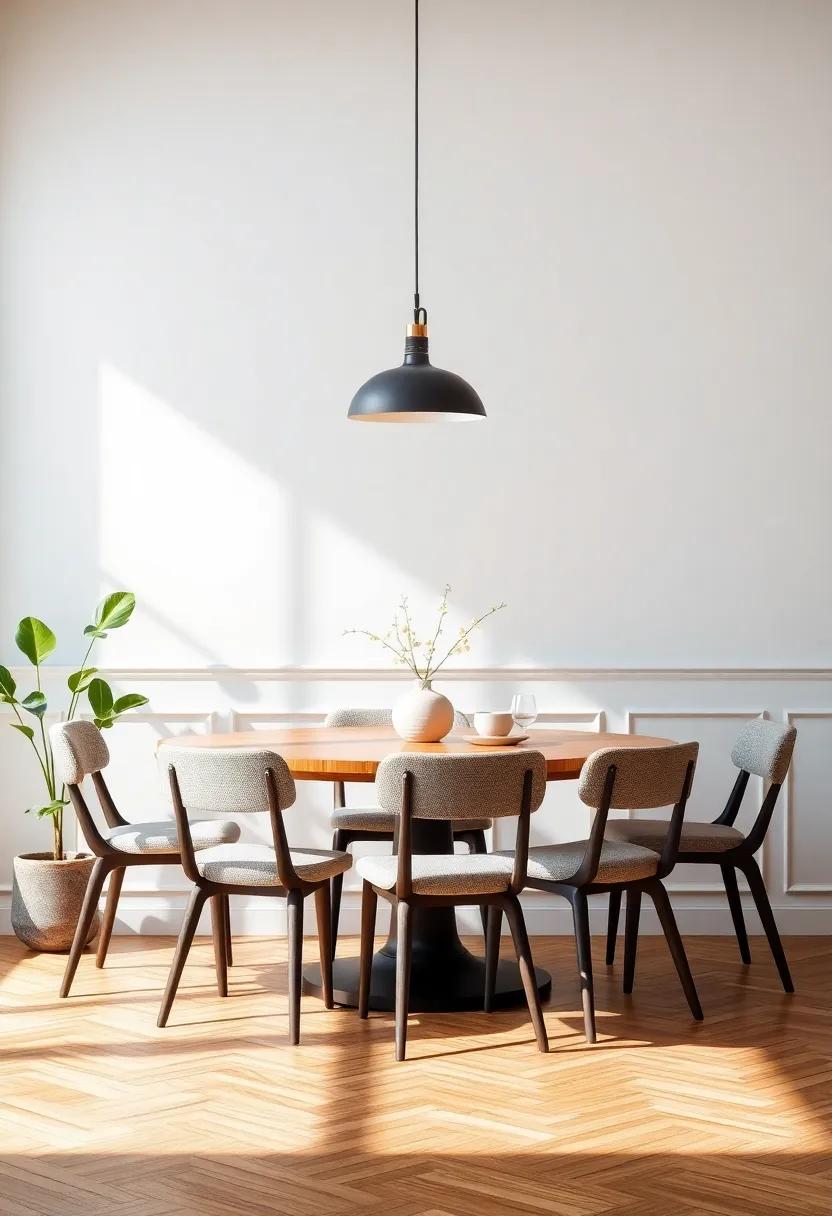
When it comes to pairing your dining room with the right lamp, the shape of your dining table plays a crucial role in achieving a harmonious look. For round tables, opting for a round lamp can accentuate the curves of the table and create a balanced ambiance. A pendant light or chandelier that echoes the table’s circular shape can draw the eye upward while fostering a sense of intimacy and warmth. Not only does this choice enhance aesthetics, but it also ensures the lighting doesn’t overwhelm the space, maintaining an inviting atmosphere that enhances conversation.
On the other hand, rectangular tables benefit from the sleek lines of linear fixtures, such as elongated pendants or horizontal chandeliers. These designs emphasize the table’s geometry and can create a striking focal point in your dining room. Select a light fixture that is proportionate to the length of the table—ideally, it should hang low enough to provide adequate lighting without obstructing views across the setting. Incorporating dimmable options can also elevate your dining experience, making it easy to transition from bright settings for family meals to warmer, softer lighting for intimate gatherings.
Use multiple light sources: Layering lighting with lamps, sconces, and ceiling fixtures will enhance depth and dynamic lighting effects
To truly transform your dining room into an inviting and warm space, consider the art of layering your lighting. Introducing a mix of light sources can significantly enhance the overall ambiance and texture of the room. Floor lamps can create a cozy corner atmosphere,while table lamps bring intimacy to the dining experience. Installing wall sconces not only saves valuable table space but also adds an appealing vertical element that draws the eye upward. Don’t forget the often-overlooked ceiling fixtures; a statement chandelier or pendant light can act as the focal point of the room, casting a broader glow that ties all the elements together.
When layering lighting, it’s essential to consider the different functions each light source serves. For instance, general lighting provides overall illumination, while task lighting focuses on specific activities like food readiness or reading menus. Accent lighting, on the other hand, highlights decor or artwork, adding character and charm. Here’s a simple guide to navigate the types of lighting for your dining area:
| Type of Lighting | Purpose | Example Fixtures |
|---|---|---|
| General | Illuminates the entire space | Chandeliers, Ceiling Fixtures |
| Task | Focuses on specific areas | Table Lamps, Under-cabinet Lights |
| Accent | Highlights features or decor | Sconces, Spotlights |
Assess your ceiling height: Higher ceilings can accommodate larger fixtures, while lower ceilings may require more compact designs
When selecting a fixture for your dining room, the height of your ceiling plays a crucial role in creating a harmonious space. Higher ceilings offer the flexibility to choose larger, more dramatic light fixtures that become the centerpiece of the room. Think grand chandeliers or oversized pendant lights that draw the eye upward and make a statement. When deciding on a fixture’s size, consider the following:
- Chandelier Height: Ensure that there is at least 30-36 inches of space between the bottom of the chandelier and the tabletop.
- Fixture Scale: Larger fixtures can overwhelm a space if not properly proportioned—balance is key.
- Design Style: Choose designs that enhance the ceiling height, such as those that feature elongated shapes or sleek lines.
Conversely, if your ceilings are on the lower side, it’s essential to opt for more compact designs that won’t feel cumbersome or cramped. low ceilings can benefit from flush mounts or semi-flush fixtures that distribute light evenly without obstructing the line of sight. Here are some suggestions to make the most of shorter ceilings:
- Low-Profiles: Select fixtures that hug the ceiling to create an airy feel.
- Light Colors: Use fixtures in lighter shades to promote a sense of openness.
- Visual lightness: choose materials like glass or thin metal to prevent a bulky appearance.
Incorporate natural light: Choose a lamp that complements your room’s natural light, allowing for a comfortable and well-lit environment

Choosing a lamp that harmonizes with your dining room’s natural light not only enhances aesthetics but also creates a welcoming atmosphere. The key is to consider the amount and direction of natural light your room receives throughout the day.For sun-drenched spaces, warm-toned lamps with soft shades can complement the existing brightness, creating a cozy vibe during evenings. Conversely, if your room tends to be darker, opt for bright, white light fixtures that can mimic daylight, ensuring that your space remains inviting at all hours.
To further enhance this balance, it’s beneficial to think about the lamp’s placement in relation to your windows. A few points to keep in mind include:
- Shade color: Select lighter shades to diffuse light and maximize brightness.
- Height: Adjustable mounts allow you to tailor the lamp’s height, optimizing its interaction with natural light.
- Material: Glass or metallic finishes reflect light effectively, adding to the brightness.
- Dimmer capabilities: choose lamps that support dimmers, allowing you to toggle light intensity based on the time of day.
Test the lighting: Before committing, test different lamps in-store to see how the light interacts with your space
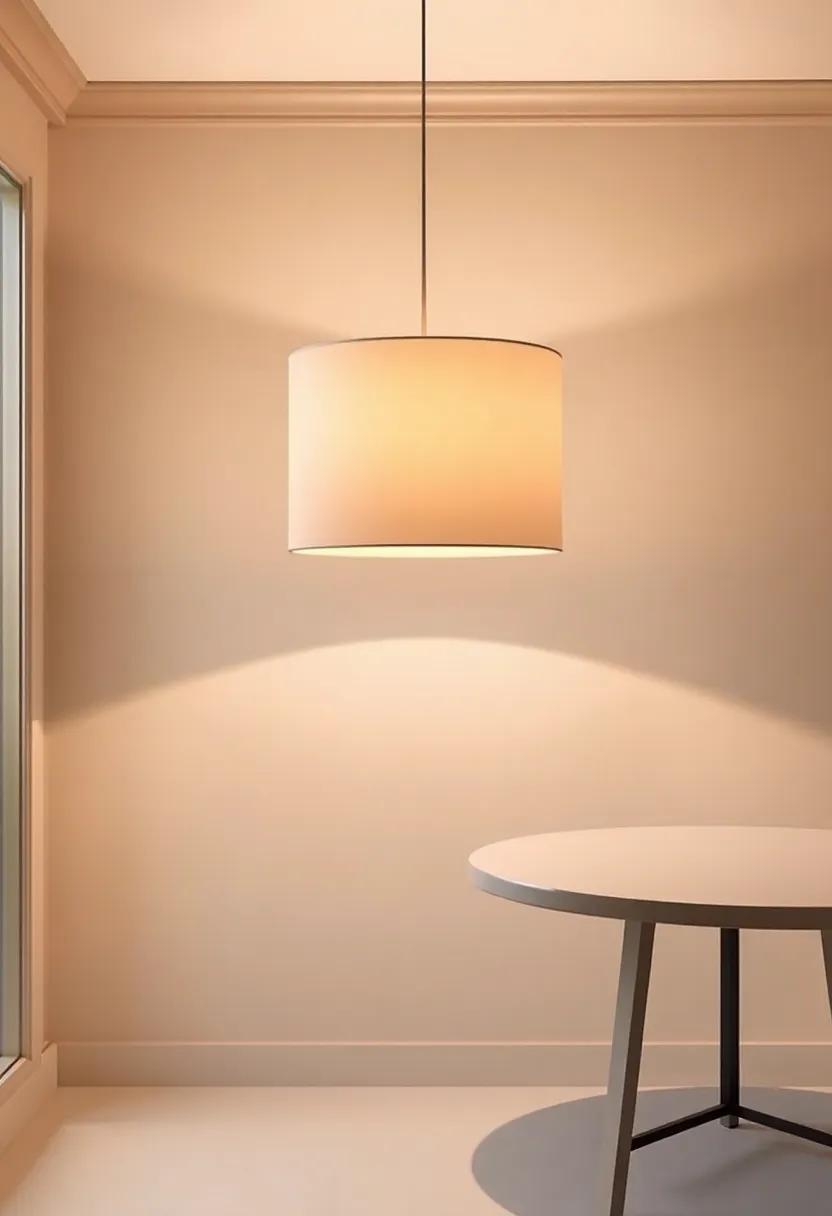
When it comes to selecting the right dining room lamp, simply choosing one that looks beautiful isn’t enough. Testing the lighting is crucial to ensure that it complements not just the lamp’s design but also the overall ambiance of your dining space.Visit your local lighting store and take several options to a designated area for a better assessment. Stack up a few different lamps to see how each fixture’s light creates different atmospheres. In-store lighting may vary greatly from natural light to artificial settings, so look actively for the model that casts the ideal glow based on your decor and color scheme.
Pay special attention to how the light interacts with your walls,furniture,and decor. You can take advantage of small tips during your in-store tests:
- Bring a fabric swatch or paint sample of your walls to see color contrast.
- Check the height; raise or lower the lamp to gauge lighting angles.
- Consider the opacity of lampshades or the finish on bulbs to understand light diffusion.
Additionally, you can create a simple lighting comparison table to track your impressions of each lamp.Use attributes like brightness, color temperature, and style compatibility to help narrow down your choices.
| Lamp Style | Brightness (Lumens) | Color Temperature (Kelvin) | Style Compatibility |
|---|---|---|---|
| Crystal Chandelier | 800 | 3000K | modern,Classic |
| Industrial Pendant | 600 | 4000K | Industrial,Rustic |
| Mid-Century Floor Lamp | 700 | 3500K | Mid-Century,Contemporary |
Account for the frame of mind: Consider how you want to feel in your dining space and choose lighting that evokes that emotion
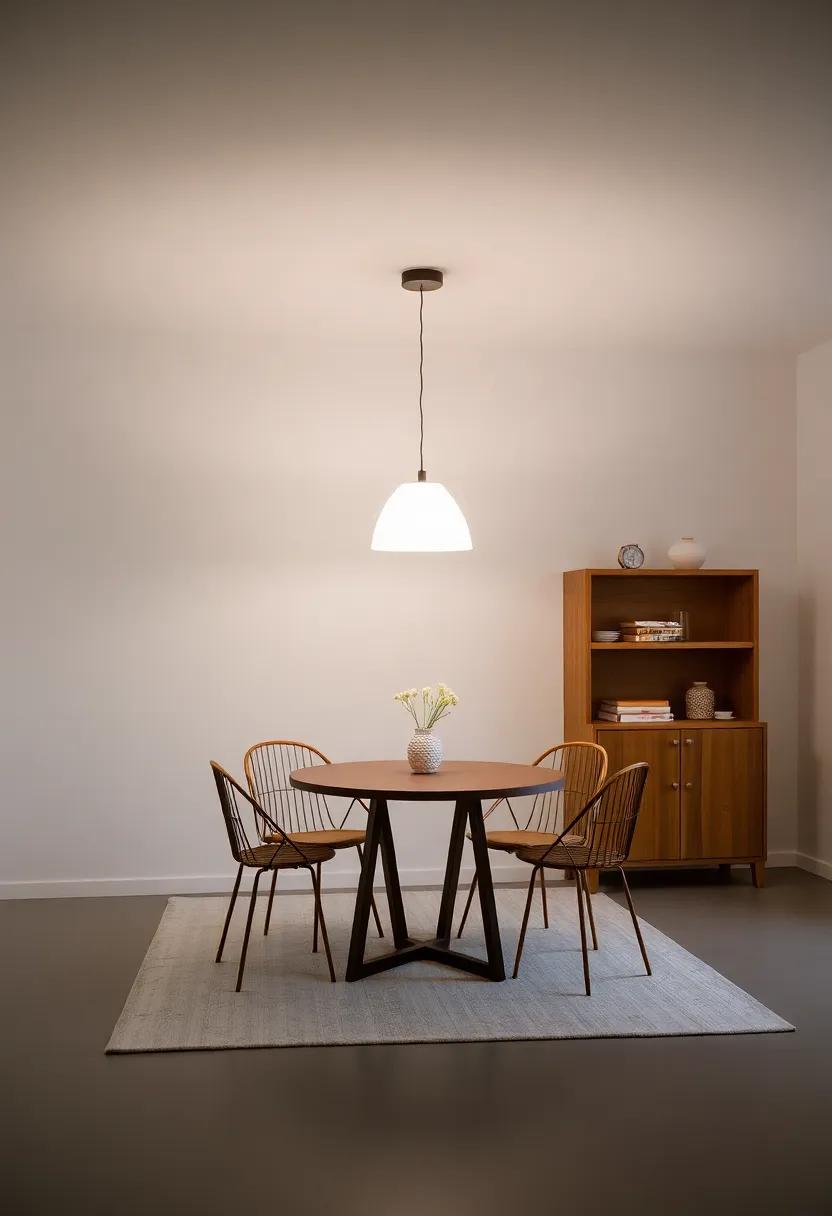
When selecting lighting for your dining area, it’s crucial to envision the kind of atmosphere you wish to create. Whether you’re aiming for an inviting feel for casual dinners or a more sophisticated vibe for elegant gatherings, your choice of lighting can profoundly influence the emotional tone of the space. Consider options that not only illuminate but also enhance the essence of the dining experience. For a cozy atmosphere, you might lean towards soft, warm tones that wrap your guests in a comforting embrace. In contrast, bold or colder tones can evoke a sense of modernity and energy, perfect for lively, entertaining evenings.
To help you narrow down your selection,think about the feelings you want to invoke and the scenarios your dining space will host. Here are some suggestions to inspire your choices:
- Intimacy: Choose dimmable fixtures or pendant lights with soft, diffused shades.
- Elegance: Opt for chandeliers or ornate fixtures that add flair and sophistication.
- Joyful gatherings: Go for bright, adjustable LEDs that create a lively ambiance.
- Relaxation: Select lamps that cast a warm glow, like Edison bulbs or lantern-style lighting.
Additionally, consider creating a table that summarizes the emotional impact of various types of lighting:
| Lighting Type | Emotional Impact |
|---|---|
| Pendant Lights | Focus and Intimacy |
| Chandeliers | Elegance and Authority |
| Wall Sconces | Warmth and Welcoming |
| Accent Lighting | Dynamic and Fun |
Examine ease of cleaning: Consider materials that won’t collect dust easily, ensuring your lamp stays fresh and appealing
Choosing the right materials for your dining room lamp can significantly simplify upkeep, blending style with practicality. Opt for options such as glass, metal, or synthetic materials, which are notorious for being low-maintenance.These surfaces tend to resist dust accumulation, allowing your lamp to maintain its shine with minimal effort. As a notable example, a sleek glass exterior can frequently enough be wiped down effortlessly with a microfiber cloth, ensuring that your lighting fixture remains a focal point without the burden of frequent cleaning.
In contrast, fabrics such as linen or velvet can trap dust and require regular washing or vacuuming to keep them looking pristine. When selecting a lampshade, consider those with smooth finishes that repel particles and grime. To illustrate these options, refer to the table below, highlighting different lamp materials alongside their cleaning needs:
| Material | cleaning Ease | Notes |
|---|---|---|
| Glass | Easy; Wipe with cloth | Shiny and modern look |
| Metal | Easy; Wipe with cloth | Durable and stylish |
| Synthetic | very easy; Wipe down | Variety of designs |
| Fabric | Moderate; Requires laundering | Softens light but collects dust |
Think about installation: A lamp that requires complicated setup might not be worth the effort—opt for user-friendly designs

When selecting a lamp for your dining room, installation should be a top consideration. A lamp that comes with a slew of complicated setup instructions and requires specialized tools can quickly turn the excitement of decorating into a frustrating experience. Instead, look for designs that prioritize user-friendliness. A well-thought-out lamp should allow you to effortlessly bring light and ambiance to your space without needing professional assistance.
Here are some features to look for in a lamp that provides a hassle-free installation experience:
- Plug-and-Play Design: Opt for lamps that simply need to be plugged into an outlet and switched on.
- Easy Assembly: Choose lamps that come with minimal parts and clear, easy-to-follow instructions.
- Pre-Wired Options: Look for fixtures that come pre-wired for quick installation, saving you time and effort.
- Adjustable Features: Consider lamps with adjustable heights or arms that can be easily repositioned without hassle.
to further assist in your decision-making, here’s a quick comparison of different lamp styles and their typical installation complexities:
| Lamp Style | Installation Complexity | User-Friendly? |
|---|---|---|
| Pendant | Moderate | ✔️ |
| Table Lamp | Simple | ✔️✔️ |
| Floor Lamp | Very Simple | ✔️✔️✔️ |
| Chandelier | Complex | ❌ |
Balance functionality with aesthetics: A beautiful lamp should not only look great but also provide ample lighting for the table
When selecting a lamp for your dining room, it’s crucial to strike a harmony between aesthetic appeal and functionality. A lamp can be a stunning centerpiece—perhaps a sculptural piece that draws the eye—but it must also effectively brighten your dining experience. Consider the size and height of the lamp in relation to your dining table. An oversized design may indeed wow guests,but if it casts shadows or obstructs views,it becomes a hindrance rather than a help. Pay attention to how the light disperses; pendant lamps or chandeliers should create a warm glow that envelops the space without being harsh or glaring.
In terms of functionality, think about the lumens—the measurement of brightness—that your lamp provides. Different dining atmospheres call for varying levels of light; cozy family dinners might require softer lighting, while lively gatherings could benefit from brighter illumination.To assist you in your decision-making, here’s a simple reference table of lamp styles and their associated brightness levels:
| Lamp Style | Brightness Level (Lumens) | Best Use |
|---|---|---|
| Pendant Light | 300-600 | Focused lighting over small tables |
| Chandelier | 600-1200 | Central lighting for large dining areas |
| Table Lamp | 100-300 | accent lighting for intimate setups |
consider dimming options for added flexibility. A lamp that can adjust its brightness allows you to easily shift from an inviting ambiance for dinner to a festive atmosphere for celebrations. Ultimately, the right lamp should enhance not just the beauty of your dining room but also the quality of your dining experiences, ensuring that both looks and light go hand in hand.
Select energy-efficient options: Choose lamps that support sustainability through energy-saving technologies and materials
When setting the mood for your dining room, consider narrowing your focus to energy-efficient lighting solutions that cater to sustainability. Opting for lamps that feature LED technology is a smart move; they consume up to 75% less energy than traditional incandescent bulbs and have a significantly longer lifespan. Moreover, many modern lamps are now crafted from recycled materials that reduce waste and promote environmental responsibility. These lamps not only help in conserving energy but also contribute to a greener planet, all while offering stylish designs to suit your dining decor.
Along with LED options, look for fixtures that offer dimmable features, allowing you to adjust the light intensity based on your needs while using less power. An increasing number of lamps integrate smart technology, enabling you to control lighting through your smartphone or voice commands, ultimately optimizing energy usage. To make informed choices, consider referring to an energy efficiency rating system when shopping. Below is a simple comparison of common lamp types to illustrate energy consumption:
| Lamp Type | Wattage (Approx.) | lifespan (Hours) | Energy Efficiency |
|---|---|---|---|
| Incandescent | 60W | 1,000 | Low |
| CFL | 15W | 10,000 | Medium |
| LED | 9W | 25,000 | High |
Explore different styles: From chandeliers to pendants, find a style that transitions seamlessly between casual and formal dining
When selecting a dining room lamp, the style can greatly enhance the ambiance of your space, whether it’s an intimate dinner for two or a lively gathering with friends.Chandeliers are traditional choices that exude elegance and formality, ideal for sophisticated dining settings. Available in a variety of finishes and designs—from crystal to modern minimalism—chandeliers can make a statement while providing ample light. Conversely, pendant lights offer a more contemporary flair, perfect for casual dining. They can be hung individually or in clusters to create a focal point above the table, with designs ranging from rustic to sleek and industrial.
For those looking to blend both styles, consider flush mounts or semi-flush fixtures, which provide versatility without sacrificing aesthetics. These options strike a balance between casual and formal, making them perfect for spaces that cater to various occasions. Wall sconces can also complement your main light source beautifully, adding depth and a layered lighting effect. if you’re aiming for adaptability, opt for a lamp with adjustable brightness settings or a dimmer switch, allowing you to effortlessly transition from a lively atmosphere to a serene dining experience.
Pay attention to shade material: Different materials can affect light diffusion; silk offers softness, while metal provides a sharper look
When selecting a shade for your dining room lamp, the choice of material plays a pivotal role in creating the ambiance of the space. Soft materials, such as silk or linen, not only add texture but also promote a gentle diffusion of light. This creates a warm and inviting atmosphere,perfect for intimate dinners and gatherings. Alternatively, materials like metal can introduce a sleek and modern aesthetic, producing a sharper, more focused beam of light that highlights dining experiences and makes every detail pop. The contrasts between these materials can significantly influence the overall vibe of your dining area.
Consider the following when choosing your shade material:
- Texture: Soft materials provide a cozy feel, while rigid materials offer a sleek look.
- Light Quality: Silk offers a diffused glow, metal brings clarity and brightness.
- Maintenance: Fabrics need more care than metal, which is often easy to wipe clean.
| Shade Material | Light Diffusion | Style |
|---|---|---|
| Silk | Soft and diffused | Classic and elegant |
| linen | Warm and inviting | Casual and rustic |
| Metal | Bright and focused | Modern and industrial |
Assess your existing light fixtures: Your new lamp should work in harmony with other lighting elements already present in your dining room
Before selecting your new lamp, take a moment to evaluate the current lighting setup in your dining room. Consider the style, brightness, and placement of existing fixtures, including overhead lights, wall sconces, and accent lamps. To achieve a cohesive atmosphere, your new lamp should complement the aesthetic and functionality of these elements.For instance, if your dining area is illuminated by a modern chandelier, a sleek, contemporary table lamp would create a harmonious visual flow. On the other hand, if your space is filled with vintage decor, an antique-inspired lamp could enhance the room’s charm.
Additionally, consider how the light from your new lamp will interact with other sources. Take note of the color temperature of your current lighting; mixing cool and warm tones can create a disjointed ambiance. Use the following table as a quick reference for matching your lamp’s characteristics with existing features:
| Existing Fixture Style | Recommended Lamp Style | Color temperature |
|---|---|---|
| Modern | Sleek, Minimalist | Cool White (4000K) |
| Traditional | Classic, Ornate | Warm White (2700K) |
| Industrial | Metallic, Raw | Neutral White (3500K) |
| Eclectic | Colorful, Unique | Warm White (2700K) or Cool White (4000K) |
Think about colors and patterns: Bold colors or intricate patterns can be used to create a focal point that enlivens the room
Choosing the right lamp can transform your dining area, especially when considering colors and patterns.Opting for a lamp that features bold hues can inject life into the room, making it a vibrant centerpiece. Think of bright reds,deep blues,or luscious greens—these shades can energize the atmosphere and spark conversation. Additionally, you can use the lamp to complement your existing color palette; for instance, a lemon-yellow lamp can brighten up a neutral space, while a rich, dark shade might add a touch of elegance and sophistication.
on the other hand, intricate patterns can serve as an artful statement piece in your dining room. Whether it’s geometric designs, floral motifs, or abstract shapes, these lamps can visually engage guests and create a feeling of warmth. When selecting a patterned lamp,consider how it interacts with your dining table décor.Ensure that the lamp’s design harmonizes with elements like table linens and dishware. A quick glance at the following table highlights potential pairings:
| Lamp Pattern | Ideal Table Décor |
|---|---|
| Geometric | Minimalistic linens |
| Floral | Vintage china |
| Abstract | Contemporary flatware |
Review the return policy: Ensure you have the option to exchange or return the lamp if it doesn’t achieve the desired look or function
Before finalizing your purchase, take a moment to review the return policy of the store where you plan to buy your lamp. A flexible return policy can save you from potential disappointment if the lamp doesn’t fit the aesthetic or functional needs of your dining room.Look for retailers that offer options such as:
- 30-day return period: This gives you ample time to assess whether the lamp complements your space.
- No questions asked exchange: An easy exchange process can ease worries about making the wrong choice.
- Free shipping on returns: This can significantly reduce costs if the lamp doesn’t meet your expectations.
Additionally, it’s worth checking the fine print.Some stores have specific conditions regarding returns, like requiring the original packaging or limiting returns to non-defective items. To make an informed decision, consider creating a quick comparison table to gauge different retailers’ return policies:
| Retailer | Return Period | Free Returns | No Questions Asked Exchange |
|---|---|---|---|
| Store A | 30 days | Yes | Yes |
| Store B | 14 days | No | No |
| Store C | 60 days | Yes | Yes |
Trust your instincts: Ultimately, choose a lamp that resonates with your style and enhances the dining experience in your home
Choosing the right lamp for your dining area isn’t just about functionality; it’s about finding a piece that speaks to your personal aesthetic. Trust your instincts when you see a lamp that captivates you, as the perfect choice should feel organic and cohesive with your existing décor. Consider elements like color, material, and design that represent your taste. Whether it’s a sleek modern pendant, a rustic chandelier, or an artistic tabletop lamp, each piece contributes to the overall ambiance of your dining experience.
As you explore your options,take a moment to reflect on what inspires you. Consider asking yourself questions like: What mood do you want to create? Are you drawn to warm, inviting tones or cool, contemporary vibes? Let these preferences guide your selection process. Additionally, keep in mind how the lamp will interact with your dining table setting and the overall room layout. Here are some key factors to evaluate that could resonate with your unique style:
- Personal Connection: Does it evoke a sense of nostalgia or excitement?
- Balance: Does it complement existing furniture and colors?
- Scale: is its size proportionate to the table and room?
The Conclusion
As we draw the curtain on our journey through the world of dining room lighting, we hope these 25 essential tips have illuminated your path to selecting the perfect lamp for your space. remember, the right lighting can transform an ordinary meal into an extraordinary experience, enhancing both the ambiance and the aesthetics of your dining area. Whether you prefer a chic pendant, a classic chandelier, or a modern floor lamp, keep in mind the function, style, and mood you wish to create.
Take your time in choosing wisely; after all, this lamp will not only brighten your dinners but also reflect your unique taste and personality. So go ahead and let your creativity shine as you set the stage for unforgettable gatherings with friends and family.Here’s to many beautifully lit meals ahead!
 efistu.com Home Decor
efistu.com Home Decor


